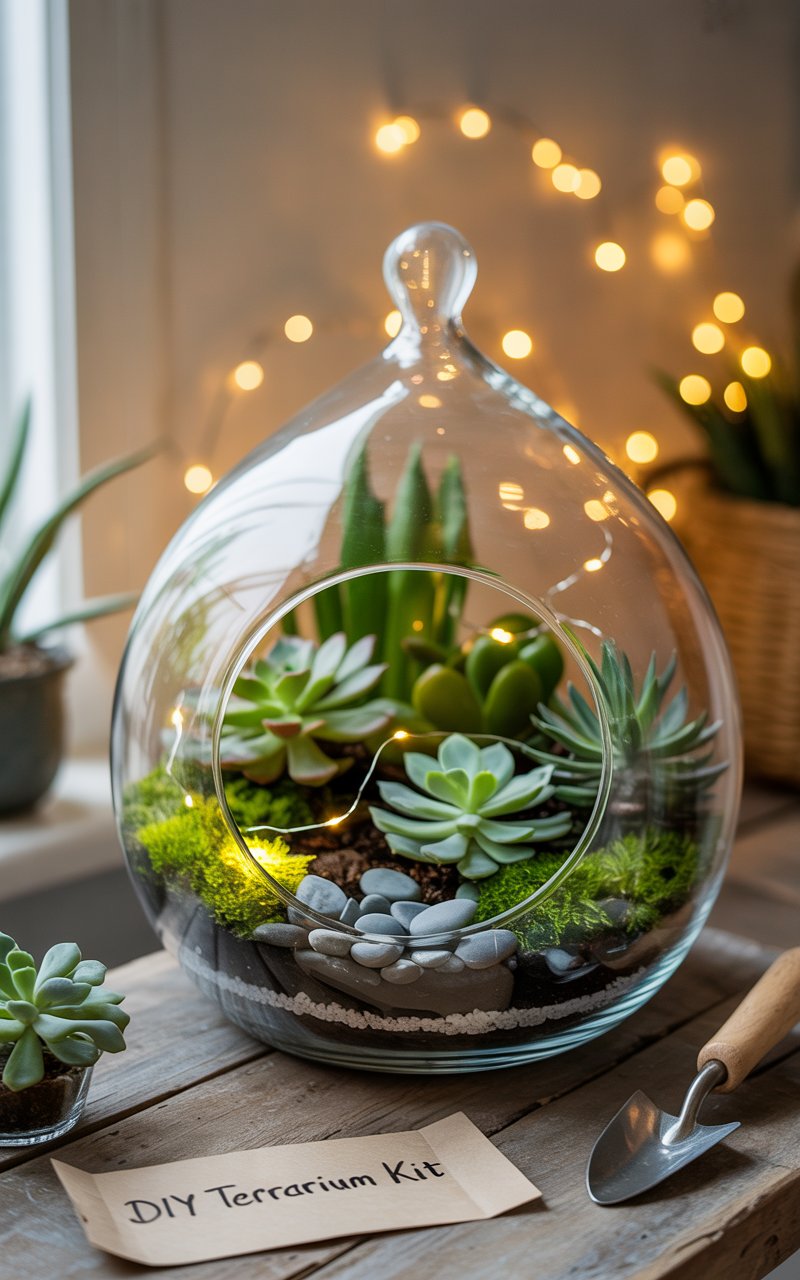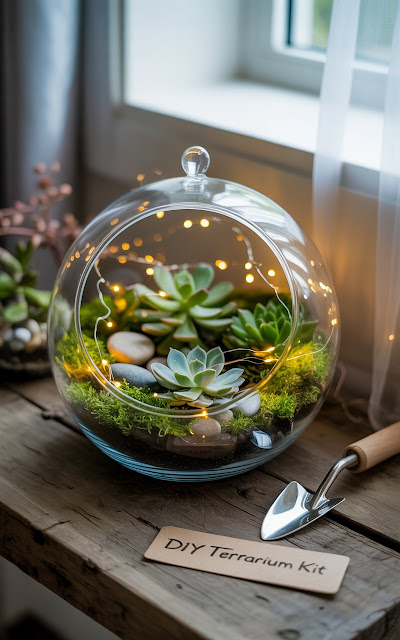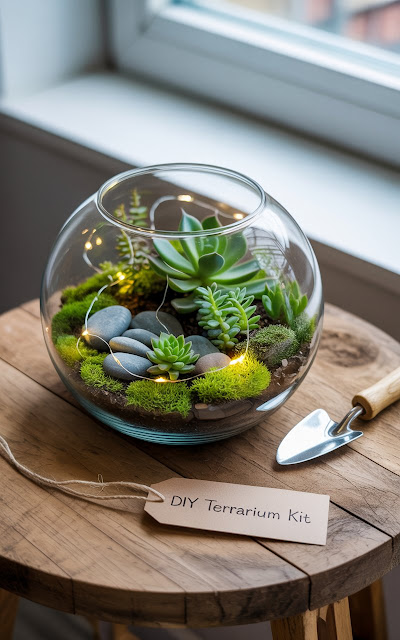Creating a glass terrarium with succulents and moss is a rewarding and creative project that brings a touch of nature into your home. These miniature ecosystems are low-maintenance, visually appealing, and perfect for adding greenery to small spaces. Whether you’re a seasoned plant enthusiast or a beginner, this guide will walk you through the process of building your own terrarium, from selecting materials to maintaining your creation. Let’s dive into the art of crafting a DIY glass terrarium that’s both beautiful and sustainable.
Why Choose a Succulent and Moss Terrarium?
Terrariums are self-contained environments that mimic natural ecosystems on a small scale. Succulents and moss are ideal for terrariums because they thrive in similar conditions and require minimal care. Succulents, with their fleshy leaves and striking shapes, add structure and vibrancy, while moss provides a lush, green carpet that enhances the natural aesthetic. Together, they create a balanced and visually appealing display that can last for years with proper care.
Beyond their beauty, terrariums are versatile. They can fit on a desk, windowsill, or coffee table, making them perfect for apartments or offices. Plus, the DIY aspect allows you to customize the design to match your style, whether you prefer a minimalist look or a whimsical, nature-inspired scene.
Materials You’ll Need
Before you start, gather the following materials. Most are available at craft stores, garden centers, or online:
- Glass Container: Choose a clear glass container with or without a lid. Open terrariums are better for succulents, as they prefer good air circulation. Options include geometric terrariums, mason jars, or fishbowl-style containers.
- Succulents: Select small varieties like Echeveria, Haworthia, or Sedum. Aim for 3–5 plants to avoid overcrowding.
- Moss: Sheet moss, cushion moss, or mood moss work well. Look for preserved or live moss, depending on your preference.
- Potting Mix: Use a well-draining cactus or succulent soil mix.
- Activated Charcoal: This keeps the terrarium fresh by reducing odors and preventing mold.
- Small Pebbles or Gravel: These add texture and act as a base layer.
- Decorative Elements: Consider driftwood, small figurines, or polished stones for a personalized touch.
- Tools: A small trowel, spoon, or paintbrush for planting, tweezers for precision, and a spray bottle for misting.
- Gloves: Optional, to protect your hands when handling soil or sharp objects.
Step-by-Step Guide to Building Your Terrarium
Follow these steps to create a stunning succulent and moss terrarium:
Step 1: Choose and Clean Your Container
Select a glass container that suits your space and aesthetic. Geometric terrariums with angled sides are trendy, while round containers offer a classic look. Ensure the container is clean and dry before starting. Wash it with soap and water, then wipe it down with a lint-free cloth to remove smudges.
Step 2: Prepare the Base Layer
Start by adding a thin layer of small pebbles or gravel to the bottom of the container. This creates a stable foundation and adds visual interest. Aim for a layer about 0.5–1 inch thick, depending on the size of your container. You can mix different colors or sizes of pebbles for a dynamic effect.
Next, sprinkle a thin layer of activated charcoal over the pebbles. This helps maintain a healthy environment by absorbing excess moisture and preventing bacterial growth. Use a spoon or small scoop to distribute it evenly.
Step 3: Add the Soil
Add a layer of cactus or succulent potting mix, about 1–2 inches deep, depending on the size of your terrarium. The soil should be deep enough to anchor the succulent roots but not so thick that it overwhelms the container. Use a small trowel or spoon to spread the soil evenly, creating gentle slopes or hills for a natural look.
Step 4: Plant the Succulents
Before planting, plan the layout. Place taller succulents toward the back or center and smaller ones toward the edges for balance. Use a spoon or your fingers to create small holes in the soil for each plant. Gently remove the succulents from their pots, shake off excess soil, and place them in the holes. Press the soil lightly around the roots to secure them. Be careful not to overcrowd the terrarium—leave space for the plants to grow and for the moss to shine.
Step 5: Add the Moss
Moss adds a lush, forest-like quality to your terrarium. If using live moss, mist it lightly with water to keep it hydrated before placing it. Use tweezers to position the moss in areas where it complements the succulents, such as around the base or in empty spaces. For preserved moss, simply arrange it as desired. Press it gently into the soil to ensure it stays in place.
Step 6: Incorporate Decorative Elements
This is where you can get creative! Add small pieces of driftwood, colorful stones, or tiny figurines to enhance the theme. For example, a miniature fairy garden bench or a tiny animal figure can add whimsy. Avoid over-decorating, as simplicity often makes the most striking terrariums.
Step 7: Final Touches
Use a paintbrush to clean any soil or charcoal dust from the succulents, moss, or glass. Mist the moss lightly with a spray bottle to settle it into place. If your terrarium is open, avoid watering the succulents immediately—wait a few days to let them adjust.
Caring for Your Succulent and Moss Terrarium
To keep your terrarium thriving, follow these care tips:
- Light: Place your terrarium in bright, indirect light. A windowsill with filtered sunlight or a well-lit desk works well. Avoid direct sunlight, which can scorch succulents or dry out moss.
- Watering: Succulents need minimal water. Water them sparingly—about once every 1–2 weeks—using a small watering can or dropper to target the soil around the roots. Moss, if live, should be misted lightly every few days to maintain humidity. Overwatering is the biggest threat to terrariums, so err on the side of caution.
- Ventilation: Open terrariums are ideal for succulents, as they prevent excess moisture buildup. If using a closed terrarium, open the lid occasionally to allow air circulation.
- Maintenance: Remove any dead leaves or debris to keep the terrarium clean. Trim moss if it overgrows, and monitor succulents for signs of stretching (a sign of insufficient light).
- Temperature: Keep the terrarium in a room with temperatures between 65–80°F (18–27°C). Avoid placing it near heaters or air conditioners.
Design Tips for a Stunning Terrarium
- Play with Height and Texture: Combine succulents with different shapes, such as rosette-forming Echeveria and spiky Haworthia, to create visual interest. Moss adds a soft texture that contrasts with the succulents’ bold forms.
- Choose a Theme: Create a cohesive look, such as a desert landscape with sand-colored pebbles or a forest scene with green moss and driftwood.
- Keep It Balanced: Avoid clutter by leaving some open space. A minimalist design often looks more polished and allows the plants to stand out.
- Experiment with Color: Use colored pebbles or variegated succulents to add pops of color. Preserved moss comes in various shades, like green, red, or gold, for a unique touch.
Common Mistakes to Avoid
- Overwatering: Too much water can cause root rot in succulents or mold in moss. Always check the soil’s dryness before watering.
- Poor Lighting: Insufficient light can cause succulents to stretch or lose their vibrant colors. Ensure they get enough indirect light.
- Overcrowding: Too many plants or decorations can make the terrarium look chaotic and hinder growth. Less is often more.
- Using the Wrong Soil: Regular potting soil retains too much moisture. Always use a cactus or succulent mix for proper drainage.
Benefits of a DIY Terrarium
Building a terrarium is more than just a craft—it’s a way to connect with nature and express creativity. The process is meditative, and the result is a living piece of art that enhances your space. Terrariums also make thoughtful gifts, as they’re unique and personal. Plus, their low-maintenance nature makes them ideal for busy lifestyles.
Conclusion
Creating a DIY glass terrarium with succulents and moss is a fun and fulfilling project that anyone can tackle. With the right materials, a bit of planning, and proper care, you can craft a miniature ecosystem that brings joy and greenery to your home. Whether you’re drawn to the sculptural beauty of succulents or the soft allure of moss, your terrarium will be a one-of-a-kind creation that reflects your style. So gather your supplies, unleash your creativity, and start building your own tiny world today!












0 Comments